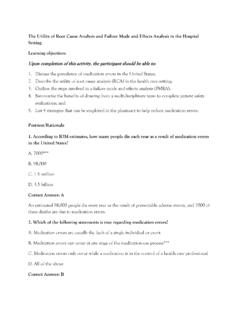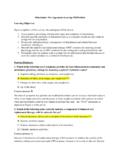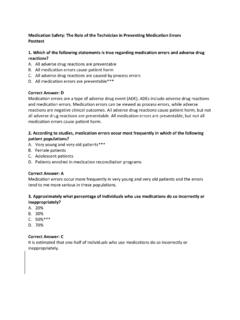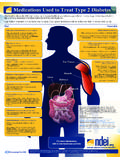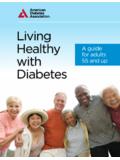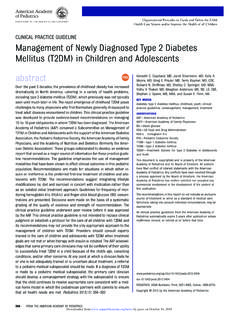Transcription of Type 2 Diabetes – Pathophysiology and Pharmacology …
1 Type 2 Diabetes Pathophysiology and Pharmacology review ( article ) educational objectives Upon completion of this activity, participants will be better able to: 1. Describe the clinical Pharmacology of the dipeptidyl peptidase-4 (DPP-4) inhibitors, glucagon-like peptide-1 (GLP-1) receptor agonists, and sodium-glucose cotransporter-2 (SGLT-2) inhibitors 2. Understand the concept of implementing combination pharmacotherapy by addressing complementary pathophysiologic targets 3. Describe the role of DPP-4 inhibitors, GLP-1 receptor agonists, and SGLT-2 inhibitors as monotherapy and in combination with other medications for the treatment of type 2 Diabetes mellitus (T2DM) Post-test/Rationale: 1.
2 Which of the following correctly characterizes a physiologic effect of glucagon-like peptide-1? A. Stimulation of glucagon secretion from pancreatic -cells B. Increased rate of gastric emptying C. Increased satiety** D. Blocked reabsorption of filtered glucose in the kidney Correct answer: C. Rationale (Objective #1): Glucagon-like peptide-1 has several physiologic effects in humans: stimulation of glucose-dependent insulin secretion, suppression of glucagon secretion, slowed gastric emptying, and increased satiety. Sodium-glucose cotransporter-2 inhibitors inhibit the reabsorption of filtered glucose in the kidney. 2. Which of the following is true of the clinical Pharmacology of sodium-glucose cotransporter-2 inhibitors?
3 A. Improved glycemic control due to increased glucose disposal via the urine B. Increased risk of genital mycotic infections C. Potential for weight loss D. All of the above** Correct answer: D. Rationale (Objective #1): Sodium-glucose cotransporter-2 (SGLT-2) inhibitors can be clinically useful in the setting of type 2 Diabetes mellitus. By increasing disposal of glucose via the urine, SGLT-2 inhibitors can improve glycemic control, induce weight loss, and decrease blood pressure. By increasing glucose concentrations in the urine, SGLT-2 inhibitors are also associated with potential side effects, such as genital mycotic infections and urinary tract infections.
4 3. When comparing the clinical Pharmacology of dipeptidyl peptidase-4 (DPP-4) inhibitors and glucagon-like peptide-1 (GLP-1) receptor agonists, which of the following is true? A. DPP-4 inhibitors are injectable agents, but GLP-1 receptor agonists can be given orally B. DPP-4 inhibitors are considered weight neutral, but GLP-1 receptor agonists therapy can result in weight loss** C. DPP-4 inhibitors slow gastric emptying to a larger extent than GLP-1 receptor agonists D. Both therapies carry a high risk of hypoglycemia Correct answer: B. Rationale (Objective #1): Both DPP-4 inhibitors and GLP-1 receptor agonists work to augment the incretin effect, but these classes of medications differ in terms of administration and clinical effects.
5 DPP-4 inhibitors are oral medications, and GLP-1 receptor agonists are currently only available in injectable form. DPP-4 inhibitors are considered weight neutral and have a negligible effect on altering gastric emptying. GLP-1 receptor agonist use, in contrast, often results in weight loss partly due to slowing of gastric emptying. Both therapies carry a low risk of hypoglycemia when used as monotherapy or as add-on to metformin, but caution is warranted when these agents are added to insulin secretagogues or insulin therapy due to a potential for hypoglycemic events. 4. When used as add-on therapy to metformin in a patient who has not achieved his or her glycemic goals, sodium-glucose cotransporter-2 inhibitors would be expected to: A.
6 Convey a low risk of hypoglycemia** B. Induce weight gain C. Have no additional benefit on hemoglobin A1c reduction D. Result in renal toxicity Correct answer: A. Rationale (Objective #2): The combination of metformin and a sodium-glucose cotransporter-2 (SGLT-2) inhibitor would be expected to convey a low risk of hypoglycemia and improve glycemic control due to their complementary mechanisms of action. The addition of an SGLT-2 inhibitor to metformin would also potentially contribute to weight loss in patients with type 2 Diabetes . 5. According to the 2017 American Association of Clinical Endocrinologists Algorithm for Adding/Intensifying Insulin, which of the following non-insulin medication classes is recommended for consideration in patients with type 2 Diabetes who require intensification of prandial control following basal insulin titration and optimization?
7 A. Glucagon-like peptide-1 receptor agonists B. Sodium-glucose cotransporter-2 inhibitors C. Dipeptidyl peptidase-4 inhibitors D. All of the above** Correct answer: D. Rationale (Objective #3): Per the 2017 algorithm, glucagon-like peptide-1 receptor agonists, sodium-glucose cotransporter-2 inhibitors, and dipeptidyl peptidase-4 inhibitors can all be considered in patients requiring intensification of prandial control following basal insulin titration. An additional option is to initiate mealtime insulin in such patients. 6. Medications from which of the following medication classes have been shown in clinical trials to convey cardiovascular benefit in patients with type 2 Diabetes mellitus and preexisting cardiovascular disease?
8 A. Glucagon-like peptide-1 receptor agonists B. Sodium-glucose cotransporter-2 inhibitors C. Dipeptidyl peptidase-4 inhibitors D. A and B** Correct answer: D. Rationale (Objective #3): Both liraglutide (a glucagon-like peptide-1 receptor agonist) and empagliflozin (a sodium-glucose cotransporter-2 inhibitor) have been shown in cardiovascular outcome trials to improve cardiovascular risk. 7. All of the following adverse reactions could be expected with sodium-glucose cotransporter-2 inhibitor use EXCEPT: A. Urinary tract infections B. Hypertension** C. Genital mycotic infections D. Orthostasis Correct answer: B. Rationale (Objective #1): Sodium-glucose cotransporter-2 (SGLT-2) inhibitor therapy has been associated with reductions of systolic blood pressure in the range of 2 to 10 mmHg in clinical trials.
9 Likewise, hypotensive events secondary to volume depletion with SGLT-2 inhibitor therapy have been reported. 8. According to the 2017 American Diabetes Association Standards of Medical Care in Diabetes , which of the following is a potential add-on for a patient receiving metformin monotherapy who is not at treatment goal and requires dual therapy (assuming there are no contraindications to therapy)? A. Glucagon-like peptide-1 receptor agonist B. Dipeptidyl peptidase-4 inhibitor C. Sodium-glucose cotransporter-2 inhibitor D. All of the above** Correct answer: D. Rationale (Objective #2): Per the 2017 Standards of Medical Care in Diabetes , agents from any of these medication classes can potentially be used in combination with metformin due to their complementary mechanisms of action.
10 9. Which of the following sodium-glucose cotransporter-2 inhibitors is recommended for use in patients with an estimated glomerular filtration rate less than 45 mL/ m2? A. Canagliflozin (Invokana) B. Dapagliflozin (Farxiga) C. Empagliflozin (Jardiance) D. None of the above** Correct answer: D. Rationale (Objective #1): Because the mechanism of action of sodium-glucose cotransporter-2 (SGLT-2) inhibitors is dependent on kidney function; these agents are not recommended for patients with diminished renal function. No currently available SGLT-2 inhibitors are recommended in patients with an estimate glomerular filtration rate less than 45 mL/ m2. 10. Which of the following glucagon-like peptide-1 receptor agonists is administered once daily?
